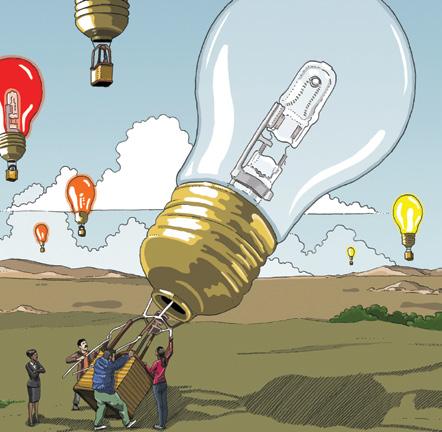
3 minute read
HANDS-ON Experience Learning BUILDING COALITIONS BUILDING COALITIONS: THE POWER OF SYNERGY
Apartheid’s legacy continues to divide us in deep and undeniable ways, but civil society coalitions across class, race and economic sectors can inspire new ways of accelerating change. This learning brief explores communications and advocacy campaigns that demonstrate the power of coalitions to effect transformation. It includes case studies of: Messages for Mothers (M4M), Youth Capital’s Part of the Action and Real Reform for ECD (also known as Real Reform).
There is a growing gap between the pace of innovation and the ability of governments and civil society to harness it for the public good. Its monetisation has concentrated global wealth and widened the gap between the top 10% and the rest of the world’s population. The pace of innovation continues to accelerate,1 largely due to the instant synergistic power of advanced technologies such as the Internet, 5G and big data analysis.2 Government and civil society must be at the forefront of ensuring that the energy and power of this knowledge capital is harnessed for broad societal benefit, but that can’t be done at a snail’s pace and in the same old ways. The speed of compound innovation – and its desirable and undesirable social impacts – requires rapid synthesis and adaptation of technology as well as changes in human behaviour.
1 https://www.kurzweilai.net/ the-law-of-accelerating-return
2 Canning, https://www2.deloitte. com/content/dam/Deloitte/br/Documents/public-sector/Deloitte-Future-ofgovernment.pdf
While in the past many civil society organisations (CSOs) made great strides by putting their heads down and staying singularly focused on addressing the need at hand, their ability to influence broader social change now largely depends on their connectedness. Within this context, the power of synergy comes from the:
› creative energy that sparks from unlikely networks;3
› the superlinear scaling properties of social networks –each time a social network doubles in size, the number of connections increases roughly fourfold;4 and
› the influence of bottom-up “political” constituencies in shaping public demand for change.5
Civil society coalitions may emerge organically for a variety of reasons:
› to make the most of limited resources and to pool the expertise available to CSOs working on similar objectives;
› to avoid duplication of effort;
› to ensure effective communication among key CSO actors; and
› to avoid disunity on an issue.6
Working in coalition also provides a coordinated way for CSOs to forge and maintain strategic partnerships with external actors. It is easier for governments to relate to a coalition as a single partner representing a range of civil society organisations than to work out whom to interact with from a range of players.7
The power of coalitions is clearly illustrated by civil society’s prompt response to the Covid-19 pandemic in South Africa.
CASE STUDY #1 MESSAGES FOR MOTHERS
A unique collaboration between South African CSOs and government was one of the first in the world to create a Covid-19 information platform for pregnant women during the pandemic. Messages for Mothers (M4M) was launched to provide credible information to mothers about the coronavirus and the impact on their families.

As the pandemic tightened its hold on South Africa in March 2020, Julie Mentor – leader of Embrace, a national movement for supported and celebrated motherhood – realised there was a dearth of reliable Covid-19 information for mothers. She consulted Dr Simone Honikman, director of the Perinatal Mental Health Project (PMHP), Dr Kopano Matlwa Mabaso, executive director of Grow Great – a campaign that aims to galvanise South Africa towards a national commitment to zero stunting by 2030, as well as Buhle Mabaso, campaign manager for Side-by-Side, a National Department of Health (NDOH) campaign for pregnant women and caregivers aimed at ensuring children under five receive nurturing care. At the time, all agreed there was urgent need for a dedicated maternal response that tapped into the most qualified maternal, physical and mental health experts in the country.
Very soon, M4M was born, and the four women became the executive team, providing strategic direction to the initiative and pouring their complementary skills, available capacity and resources into the project. All content was open-source and 6
Diverse groups came together to reduce the risk of new infections, help feed millions of hungry people during the hard lockdown, lead advocacy work for the reduction of alcoholrelated harms and support for foreign nationals and migrants, among other initiatives.8 unbranded to ensure information was accessible and easy to share. This information was made available across a range of channels, such as: NDOH platforms, including the Covid-19 WhatsApp line; community radio stations; the M4M website; the M4M newsletter (sent to 2 700 organisations working with caregivers and mothers); and pamphlets distributed in the Western Cape.
Arguably, in a resource-constrained environment, new synergy is the most likely source of accelerated change over the next decade. The challenge for civil society (and for governments and multilateral institutions) is to move beyond collective talk to convergent action.
“Something about M4M appealed to moms of different races and different economic backgrounds, which as a national programme, you always hope for but don’t always get quite








